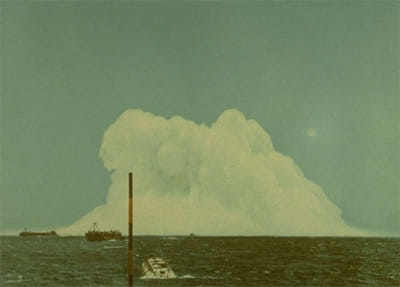Operation Wigwam
Operation Wigwam involved a single test of the Mark 90 Betty nuclear bomb conducted 400 miles southwest of San Diego. It was a deep water test to investigate the vulnerability of submarines to deep nuclear weapons, and the feasibility of using depth bombs in combat. 6800 personnel on 30 ships participated in Wigwam, including members of the Scripps Institution of Oceanography and Roger Revelle, who served as Chief Oceanographer for the Navy's postwar atomic tests.
"Airborne monitors stationed at San Diego measured a higher level of radioactivity over that city within four days of the blast. The radioactivity ranged from ten to twenty times the normal background levels for the next nine days."
The test device for Operation Wigwam was a B-7 (Mk-90) Betty depth bomb that was suspended by a 2000 ft cable from a barge. The dry weight of the bomb was 8250 lb, 5700 lb when submerged.
| Date/s | May 13, 1955 |
| Taxonomy | technology » weapons » atomic |
| NRHP classification | event-research-defense-nuclear |
| Location | 32.87677764892578, -117.26205444335938 |
| Budget | $15,234,176.37 |
| Sources | |
| See also |    |
| Record created | March 7, 2012 |
